Fokker. Man and plane. Part three
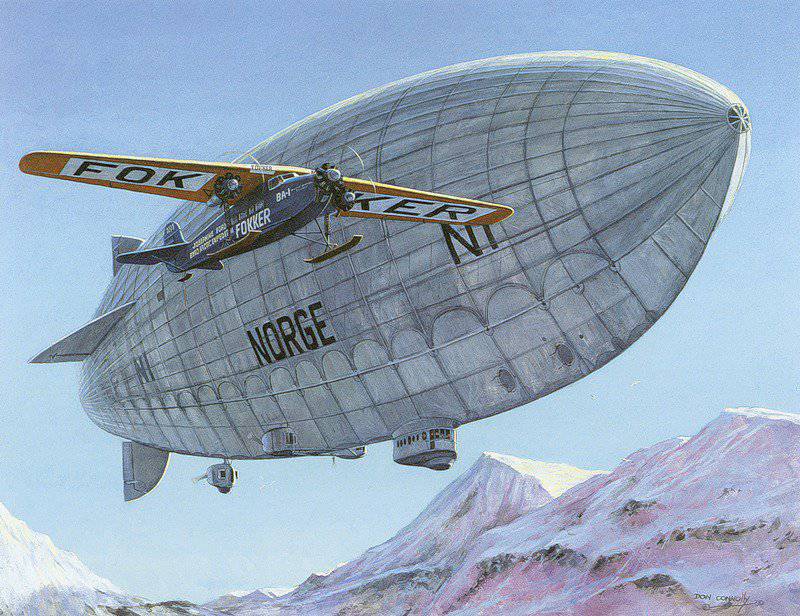
In the summer of 1919, the first post-war war opened in Amsterdam. aviation Exhibition. Holland, France, England and Italy participated in it. Fokker instantly grasped the idea in the air: Holland could play an important role in aviation. In fact, after the war, the victorious countries did not develop either new military or civilian aircraft, trying either to quickly get their hands off the aging products of the war years, or somehow adapt them for civilian needs. The defeated countries, deprived of the right to create combat vehicles, focused on civilian aircraft construction. In neutral Holland, the ideal situation was for the development of both military and civil aviation.
In July 1919, Fokker founded NV (Nederlandsche Vliegenfabriek - Dutch Aviation Plant). Chief Designer R. Platz, on orders from Fokker, developed the first four-seater aircraft - a prototype of a long series of passenger aircraft, which in 20's carried the glory of Anthony Fokker around the world.
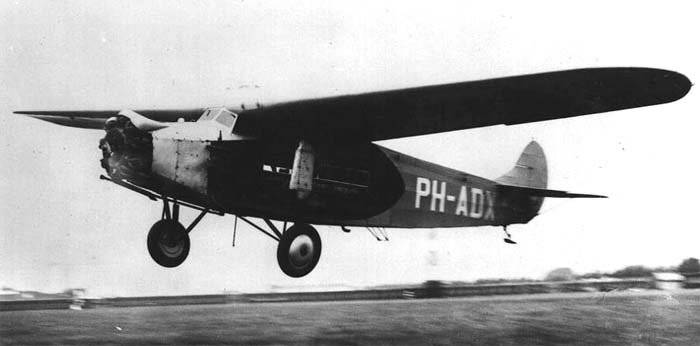
During the operation of the Fokker machine, they quickly proved their reliability, and at the end of 1923, the KLM (Royal Dutch Airlines) leadership ordered an NV passenger aircraft for 8 seats. The design was “typically Fokker's”: a cantilever two-spar wing of a thick profile with plywood skin and a fuselage with a steel pipe frame. The pilot's cabin was supplied with dual controls upon the customer's request, and the chassis had a reinforced structure for landing on unprepared sites. The design of this machine was headed by Walter Rethel. The work proceeded quickly, and 11 on April 1924. Single-engine high-profile F.VII made the first flight. Although the tests were successful, and the board of KLM remained sufficient, they built only 5 aircraft ...
We present only the facts. V. Rethel parted with the company and returned to Germany. R.Platz arrived in his place, taking Jan Rosenshon, Maurice Billing, and Bert Graze as assistant engineers. The new design team has begun to modernize F.VII. Graza designed a new wing with elliptical ends. The form of the aileron has also changed - now they were inscribed in the contours of the wing. Rosenson replaced the pyramid landing gear with a more elegant design. These improvements have improved the aerodynamics of the aircraft and somewhat changed its appearance. Contrary to the well-established practice, Antoni Fokker did not assign a new serial number to the aircraft, but used the old one, slightly changing it, now the machine was called F.Vila. What was the reason for the departure from the tradition? Perhaps in the recent success of F.VII, who flew from Amsterdam to Batavia (now Jakarta).
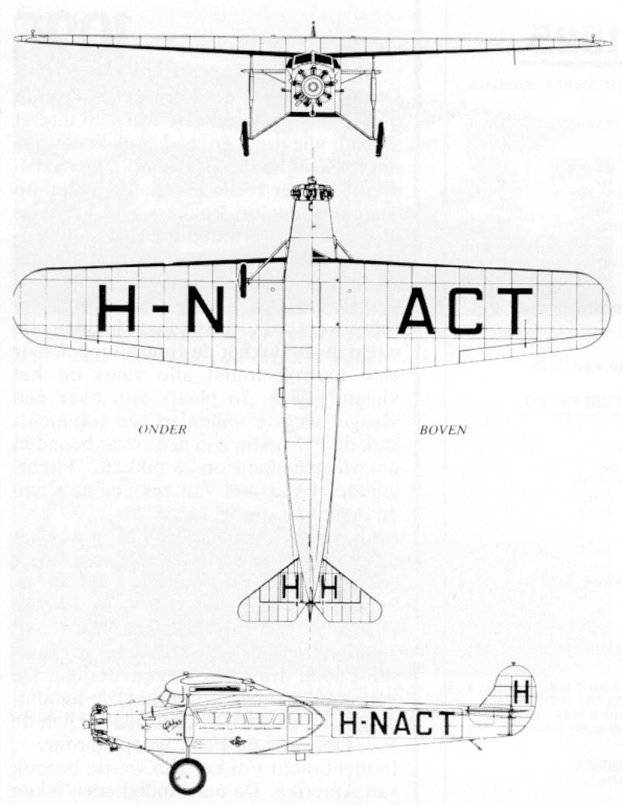
It is curious that the company took up the modernization of F.VII on its own initiative, and at first it did not arouse the enthusiasm of consumers. But when Graza, who was a good pilot, set several records for height and rate of climb on the new models, even the hearts of KLM officials thawed. In demonstration flights, Graz carried out “dead loops” and “immelmans” unusual for passenger cars. The effect of the flight was deafening: the "seven" won the hearts of Europeans. The planes ordered by the Dutch airline were equipped with Gnome-Ron Jupiter 400-powerful air-cooled motors, but the British Bristol-Jupiter engines, which had the same power but higher reliability, became the main power plant of the G-7.
Fokker has long attracted the American market. Once he had already tried to get there, and then fate gave him a new chance. In 1925, the city of Henry Ford and his son Edzel announced a competition for the reliability of aircraft (Ford Reliability Tour). In 6 days, participants had to travel about 2000 miles on the route Detroit - Chicago - Iowa City - Kansas City - Indianapolis - Columbia - Cleveland - Detroit. Fords were not philanthropists. The main purpose of the "tour" was advertising aircraft "Ford". The American automobile king became interested in commercial aviation at the beginning of the 20s, when no one in the USA thought about air traffic. To gain experience, Ford opened a regular airline between Detroit and Chicago, which serviced Ford enterprises, and brought U. Stout to the aircraft designer’s business. Stoyt studied the experience of European firms, where Fokker and Junkers dominated at that time. The first was a supporter of timber-wooden structures with a wooden wing and a fuselage, the frame of which was welded from steel pipes. The second was the pioneer of all-metal aircraft and corrugated duralumin. Fokker machines were cheaper to manufacture, did not require complex and expensive equipment, but the Junkers were more resistant to non-binded storage and worked well in different climates. Stoith combined all these advantages: he took the Fokker aircraft as a prototype, but made it all-metal, following the example of Junkers.
Confident in the high qualities of his "Tin Goose", Ford was not afraid to offer Foker to take part in the competition. Advertising in the Americas was required and Fokker. And for this we needed a victory, which could provide thorough preparation. And now Fokker sends a telegram to the company: urgently install two additional motors on the "seven". Recently, he and Platz have already figured out how F.VII might have looked with them. Fokker offered to "drown" them and the engine nacelle in a thick wing. But to implement this option without a serious rework of the wing set in a short time turned out to be impossible. And Platz sacrificed aerodynamics in favor of time, “hanging up” both engines under the wing on the chassis struts. Arrangement of all three motors "Earlwi-4" hp power 200 in one plane, he was able to completely eliminate the occurrence of unfolding moments. Leaving the wing intact, Platz achieved another win, which itself promised an increase in consumer demand: the usual “seven” easily turned into a bi- and trimotor. From a practical point of view, the design turned out to be perfect, and its influence is still felt in the mounting of jet turbines suspended on pylons under the wings of modern airliners.
4 September 1925 F.VIIa-3m (3m - three-engined) first flew into the sky, and three days later Anthony Fokker personally showed the public his new aircraft. Immediately after the "presentation" trimmer disassembled and sent to the United States. He arrived in Detroit on October 26, two days before the start of the competition. Never forgetting that advertising is the engine of commerce, Fokker ordered to write the name of his company in huge letters on the wing and fuselage of the aircraft.
A few days later, thousands of Americans scored roads leading to the town of Dearborn, near Detroit. Beginning to darken, sowing fine cold rain. At the Ford airport, a powerful searchlight was lit, a beam was sent to the sky to at least somehow break through the dense foggy curtain. But everything was dull, hopeless ... And suddenly a plane descending steeply descending from the low clouds, roaring with three engines, on the wings and fuselage of which the large letters read: "Fokker." The crowd screamed, whistled, stunned into pipes, and under this purely American accompaniment a second airplane with a shiny corrugated metal lining fell out of the clouds. It was a Ford Tin Goose. Thus ended the famous reliability competition organized by Ford - the Ford Reliability.
An experienced advertiser Fokker really managed to turn the competition into a demonstration of the merits of his trimmer. Cutting down the parking time to the limit, he flew out of them before anyone else, so that he could arrive at each intermediate point first. This trick was a success. And although the least time in flight turned out to be at the Ford Tin Goose, so he was the official winner of the competition, the entire provincial press wrote mostly about Fokker. It is not by chance that one American newspaper sarcastically re-named the “Ford Reliability Stage” in the “Fokker Publicity Tour” - “Fokker Advertising Competition”.
Immediately after the competition, Anthony proposed to conduct a comprehensive trimotor test, after which he overtook him in Dearborn. Here, Ford's son Edsel examined the car and was so delighted that he convinced his father to buy it from Fokker. Edsel Ford purchased the trimmer and for the polar expedition of Richard Byrd. The aircraft was named Josephina Ford, in honor of the youngest daughter of the sponsor. But the irrepressible Fokker, in the sale, demanded that his name be written on board, and as large as possible. Byrd agreed, joking that he would fly to the pole on the billboard. And now 9 in May 1926-th new F.VIIA / 3m, having flown to Svalbard, headed north. The whole civilized world with excitement watched the daring flight of the three-engine “Fokker” to the top of the world. No need to have excessive imagination to imagine all the unusual and dangerous first manned flight over the endless expanses of the Arctic Ocean! 2575 km lay from Svalbard to the pole and back. Fokker covered this distance in 15 h 30 min at an average speed of 166 km / h. A plane that today you can admire, if you can visit the Ford Museum.
В history Aviation This legendary raid entered as the first successful attempt to fly over the North Pole. Richard Byrd was ahead of Amundsen himself, who was preparing the “Norway” airship for a transpolar flight. However, after half a century, there were revelations that Byrd did not reach the goal. This often happens with American priorities. But, be that as it may, F.VII, thanks to this unique and extremely risky flight, has already become one of the best planes of its time. The following year, polar explorer X. Vipkins, on the Fokker Trimotor "Southern Cross", flew from North America to Australia in nine days - a grand one for those times: at a distance of 11 thousands of kilometers. And in 1927, the Fokker trimotor "Bird of Paradise", bought by the American army, flew from San Francisco to Honolulu in the Hawaiian Islands.
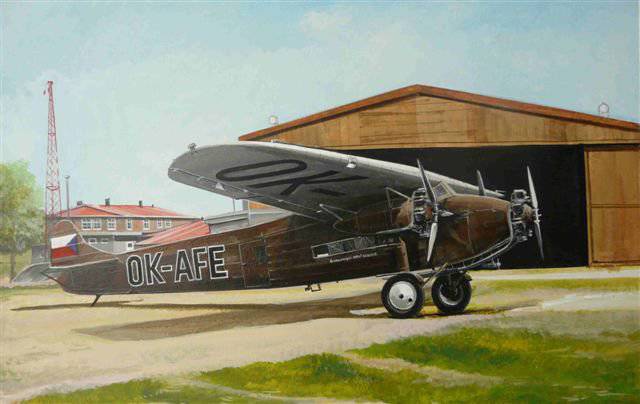
In the history of F.VII there were also black pages. As you know, in May 1927-th Charles Lindberg made an outstanding non-stop transatlantic flight alone from the continent to the continent, breaking 5809 km in 33 h 30 min. In response to this, in August of the same year, the British Hamilton and Mushin on a single-engine F.VIIA / 1 tried to break this record on the route England-Canada. But while flying over the ocean, the connection with the aircraft was interrupted, and he was forever missing.
But they say excitement is irrepressible. The lucky roulette was launched, and Charles Kingsford-Smith with his crew on the three-engine F.VIIV / 3m “Southern Cross” from 31 May to 9 June made a grand, the first in the history of aviation over the Pacific from USA to Australia Of course, with intermediate plantings. But after all, the distance was literally amazing - 11260 km, covered in 83 h 38 min flight time! Do not forget that the calendar was just 1928 year ...
During his long life, F.VII fell into extreme situations countless times, but in most cases he left them with honor. So, in 1928, the Poles Kalina, Stsalas and Klozinak flew to F.VIIA from Deblin to Iraq. In front of Baghdad, the plane was thrown down by a powerful downward stream a few hundred meters, but the car broke down and did not fall apart. The crew escaped with bruises and abrasions. 28 November 1928 th aviators Byrd, Walchen, June and Kimley started at F.VIIA / 3m from Rosbarra towards the South Pole. It was the hardest flight. The car, overloaded with fuel, could not gain the height necessary for the flight through the glaciers. It was necessary to drain part of the fuel during the flight. But new troubles came - icing and shaking of engines. But of all the troubles, Fokker returned unscathed, having reached the goal of the flight. Thus, the car of Antoni Fokker obeyed both poles - the two most difficult points of the globe. But perhaps the most original trick was made by F.VII, who stayed in the air ... 150 h 40 min! It was a record of flight duration. The aircraft with the tail number C-2А and the inscription on the fuselage “Qvestion Mark” (“Question Mark”) flew along a closed route both day and night. At a certain time, a biplan gasoline tank appeared over it, the cars leveled flight speeds, and the tanker lowered the refueling hose ...
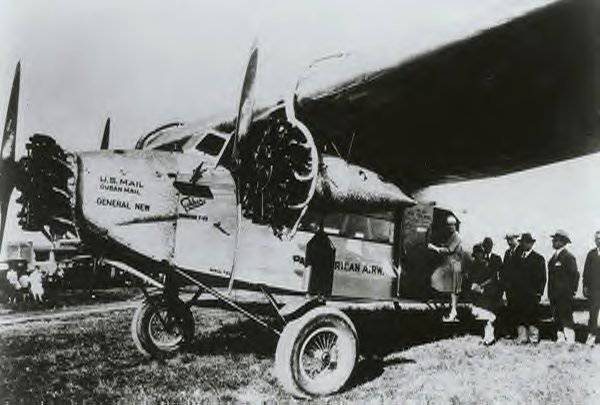
Advertising has done its job, and Fokker trimmers bought the United States, Switzerland, Spain, Portugal. Italy, Czechoslovakia, Hungary and Romania. Licenses for Fokker cars were purchased even by the French and the British, who had their own highly developed aviation industry, only sixteen companies and state-owned airlines in many countries. Moreover, the aircraft was adopted by the American Air Corps (USAAC). Officially, it was thought that the planes (they were called the “7 model”) were manufactured in the USA. In fact, Fokker’s Atlantik Aircraft Company, a subsidiary, only assembled Trimotors from finished parts and installed American engines on them.
These flights, records, reports of Black made the Fokker-Trimotor not just popular. In the eyes of the then fat cats F.VII became fashionable and prestigious (approximately the same as the 600 th Mercedes in the eyes of the “new Russians”). And the cost of the aircraft was not too high: “only” 37500 dollars. Wealthy people, such as the emperor of Ethiopia Haile Selassie, the viceroy of India, the Rothschild banker or the Czech shoe “king” Batya, purchased F.VII for personal use.
Among the powers that be, very eccentric persons also met. Thus, the Swiss Willy Zitz ordered to trim the cabin of his plane with a Karelian birch, and the Belgian financier Alfred Lowenshteyn, who did not like delays on the way, purchased an entire squadron of 9 machines, which changed at intermediate airfields, like horses at postal stations. Lowenstein’s death is just as amazing as his life: while flying in the summer of 1928 in one of his Fokkers over the English Channel, the banker went to the toilet and did not return! After about half an hour, the concerned secretary went in search of the patron, but did not find him in the toilet. Only one thing remained - Lowenstein, who had become very scattered lately, mistakenly opened the front door and stepped into the sky ... To prevent this from happening in the future, Fokker ordered a special dead bolt installed on the front door of all airplanes, which the company called the Lowenstein Deadlock. .
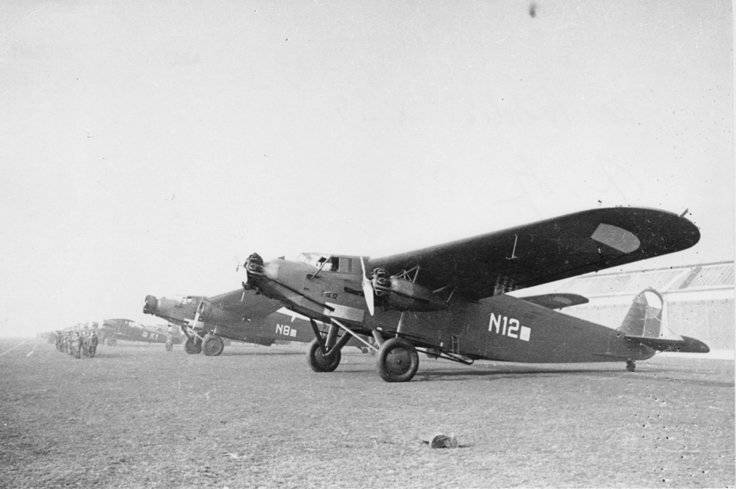
The next step in the world history of the development of passenger aircraft was the creation of four-engine cars. And the first to do it again A. Fokker. In 1929, his U.S.-based company released the F-32 — a 32-seat monoplane with an upstream wing and four Pratt-Whitney “Hornet” engines installed in tandem in two nacelles under the wing. The passenger compartment was divided into four compartments, with eight people in each. Crew - 2 person. However, the first copy of the aircraft, sold by one of the American airlines, crashed in November 1929. During takeoff, both engines on one wing failed one after the other. The car spun, it slipped on the wing and fell. Fortunately, the passengers managed to get out of the plane before the fuel tanks exploded. Despite this incident, customers still found the plane - while Fokker enjoyed great prestige in the United States. True, there were few of them, and the release of the F-32 was limited to 10 aircraft. They flew in the airline "Western Air Express" on the route Los Angeles - San Francisco, as well as used to transport mail and passengers across the country - from the Pacific Coast to New York.
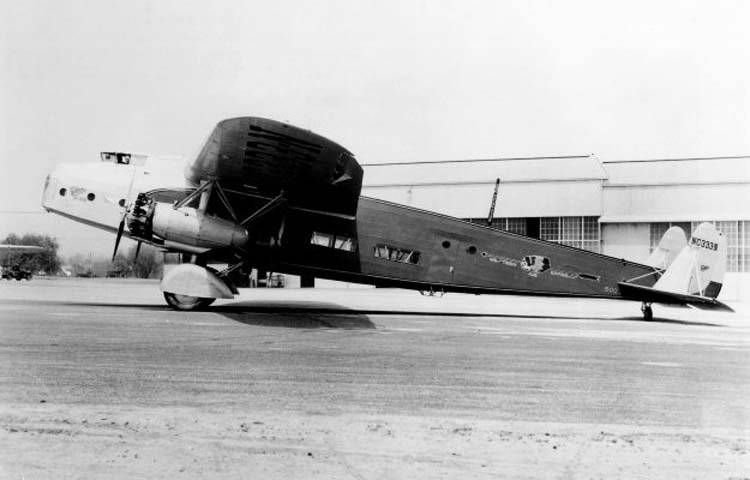
In the middle of 30's, Fokker's name disappears from the pages of newspapers and magazines. In aviation circles, other names are in the spotlight, the advantages and disadvantages of other aircraft are discussed.
What is the matter? What happened? Why did the planes that the Fokker company continued to develop in Holland no longer attract attention? Fokker in the 1930 — 1933 years designed about a dozen of new, very sophisticated aircraft, but none of them went into a large series. As if the fortune itself turned away from Fokker. The case was most often limited to five, three, two built machines, and often only one experienced one. Despite the strong competition of Ford, which produces metal planes, including Fokker remakes, Anthony’s business went superbly, orders for new cars came even from Japan and China. In the USA at the end of 20, more than a third of all transport aircraft accounted for the Fokkers. Ford Trimotors were in second place. Only in 1931, the American overtook the Dutchman in the number of cars built. But this happened later, and at the end of 20-ies Fokker was at the top of the wave.
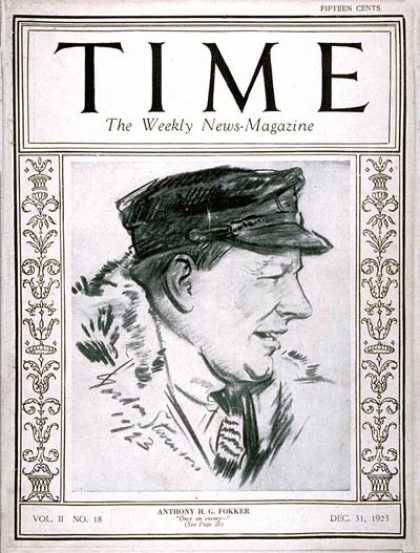
He was going to build the world's largest aircraft factories in California, to create unprecedented airliners. These dreams were destroyed by a series of catastrophes that overtook the Fokker vehicles in the USA in 1929. And although the investigations revealed that the designer was not involved in these disasters, trust in Fokker was shaken, and some airlines hurried to burn the cars bought from him, widely informing the public about this. Technical problems were accompanied by friction in the business world: in May, 1929, the concern General Motors bought 40% of the shares of the Fokker company, and Anthony was subordinate to the board, a group of people who understood little about aviation. One of the conditions of government was the renaming of “Fokker Air Corporation” to “General Aviation Corporation”. Already concluded by Fokker contracts were executed, after which the construction of his cars in the United States ceased.
Anthony tried to get a large order in his homeland, in Holland. In 1932, it seemed to work out. In the endless pursuit of speed, KLM ordered NV to design the aircraft for its East Indian routes. The new car was supposed to be at 55 km / h faster than those in service. The new Fokker F.XX Zilvermeeuw aircraft (herring gull) was the last wooden and last three-engined aircraft built by the Fokker company. At the same time it was the first aircraft of the company, equipped with retractable landing gear.
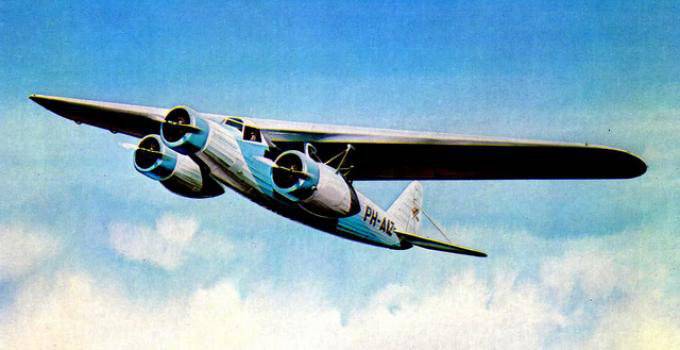
Fokker F.XX was introduced to the public on December 20 1932 of the year. Built under the direction of Marius Beeling (Marius Beeling), the aircraft had a classic Fokker fuselage with a construction of steel-coated steel pipes. The fuselage was an oval cross-section, which was the first time on the company's aircraft. Earlier Fokker aircraft had a rectangular hull. The Fokker F.XX was a high-winged plywood-covered wooden wing. Plywood trim of the lower part of the wing passed through the fuselage so that passengers are provided with the greatest possible height of the cabin. With a full supply of fuel, the range was 1700 km, with a full payload of up to 645 km. The Fokker F.XX developed a maximum speed of 305 km / h and a cruising speed of 250 km / h.
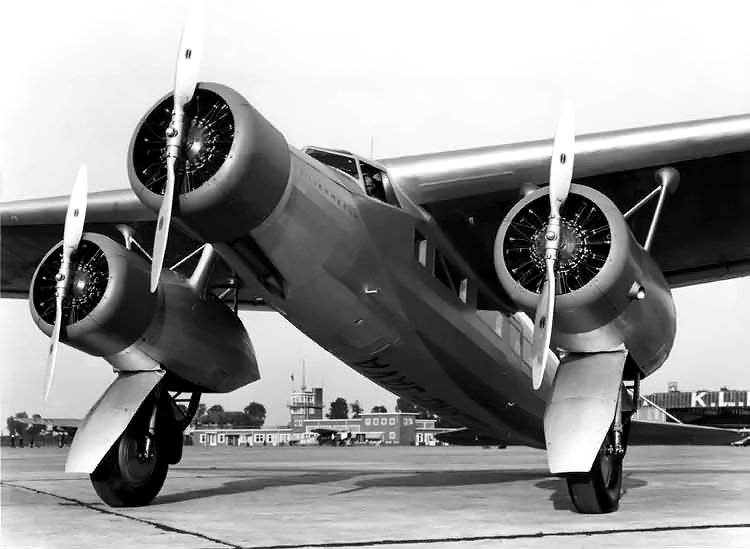
And suddenly, when the prototype F.XX was almost ready, Fokker learned that the head of the Dutch airlines Plesman was about to enter into negotiations with the American aircraft manufacturer Douglas to acquire its aircraft. Anthony was shocked. He understood that to create an aircraft capable of competing with the twin-engine all-metal streamlined "Douglas" made by new technologies, a general reconstruction of its plants is necessary. In a feverish search for a way out, Fokker came to a paradoxical solution - buy from Douglas a license to manufacture and sell aircraft of this company in all Western European countries! And when Plesman addressed his proposal to the Americans, it turned out that negotiations on this order should be conducted with the license holder - Fokker ...
Of course, it was revenge to the apostate Plesman, but in fact the purchase of a license did not facilitate the position of Fokker: his plants in Holland did not become newer, they did not have the equipment necessary for the production of all-metal "Douglas". The modernization of the factories required money, but Fokker did not have it. And although before the start of the Second World War, he managed to sell about a hundred Douglases in Western Europe, not one of them was built in Holland. They ended in failure and his attempts to penetrate the British aircraft industry in order to organize the production of "Douglas" there. England, already threatened with entry into the war, prevented the appearance of a foreign national in its holy of holies — in aviation. In 1936, Fokker made sure that his field of activity narrowed to the limits of only tiny Holland. It was at this time that some newspaper called him "The Flying Dutchman", for which his homeland is too small.
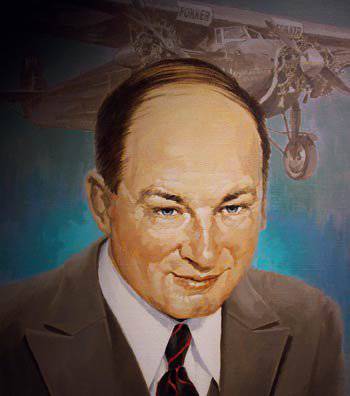
A new era in aviation, which began after the 1929 — 1931 depression, led to the prosperity of aviation figures of a completely different type than Fokker. The lengthy systematic work necessary to create a solid company, she rejected him. And although in the fever of 20's, business sense helped him to make some necessary decisions, he was deprived of a sense of perspective - the onset of the era of all-metal aircraft construction caught him by surprise. From 1935, Fokker was in a state of permanent depression. "No no! Don't tell me anything about airplanes! - He warned a friend at the meeting. “I don’t want to think about them anymore!” In this apathetic, sluggish, flabby man, Fokker of past years could hardly be recognized - active, quickly lit by plans, always dressed in broad costumes with many pockets for notebooks, pens and pencils. Everything that interested him in the airplanes of his competitors, he wrote down, copied, photographed. He was one of the first amateur cameramen, leaving for the history of the footage, capturing the figures of the aviation industry, pilots aces Richthofen and Foss. Fokker's personal life did not work. “I was too absorbed in my own affairs and could not make up the happiness of the women I loved,” Anthony once said. “It seemed to me that there is nothing in the world more important than my airplanes.” It seems that these words shed some light on the real causes of his unexpected early death.
Leo Tolstoy believed: a person dies from the fact that “the blessing of his true life” can no longer increase, and it seems to people from the outside that he is dying from lung disease, cancer, or from being shot or thrown at a bomb. The Fortune of the True Life of the Flying Dutchman ceased to increase from 1930 — 1932, when its planes ceased to lead in the development of aviation. And the doctors at New York's Murray Hill Hospital, 23 December 1939, who ascertained Fokker's death, ingenuously believed that it came from an infection after surgery in the nasal cavity ...
Использованная литература:
Pinchuk S. Fokker Dr.I Dreidecker Fighter.
Kondratyev V.V. Fighters of the First World War.
Kondratyev V. The Fokker Fighter.
Kondratyev V., Kolesnikov V. Fighter Fokker D.VII.
Smirnov G. The Flying Dutchman // Inventor-rationalizer. 1982. No.8.
Ershov S. The Adventures of the Magnificent "Seven" // Aviamaster. 1997. No.1.
Smyslov, O.S. Aces vs aces.
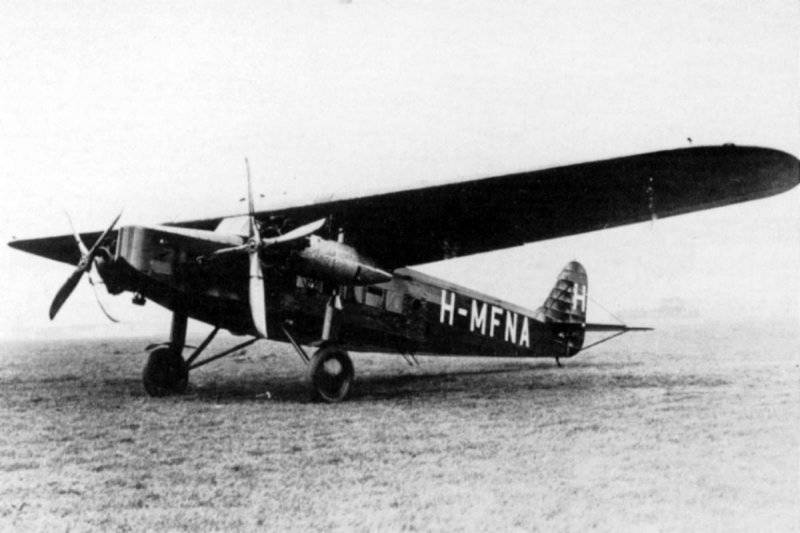
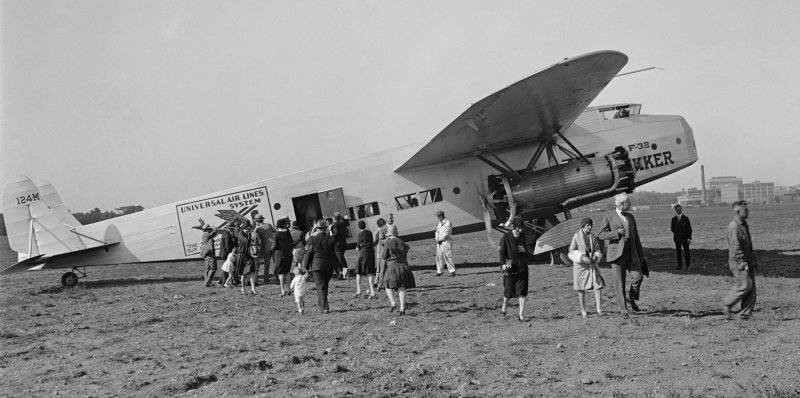
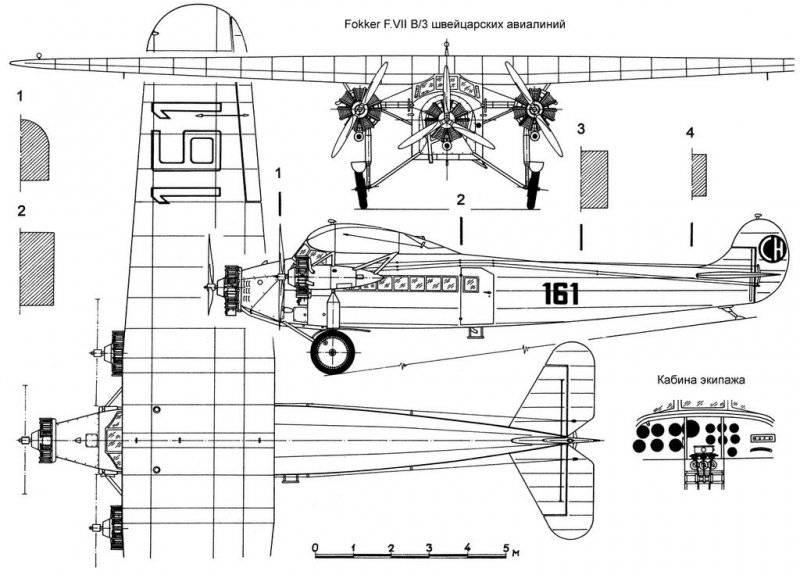
Information